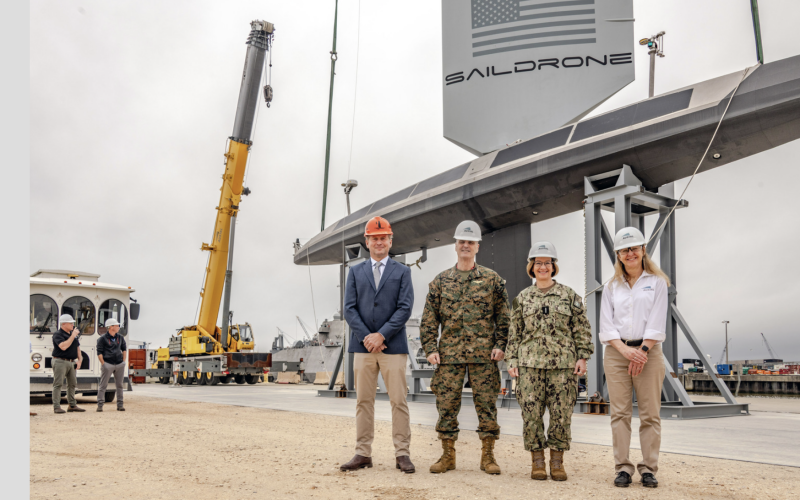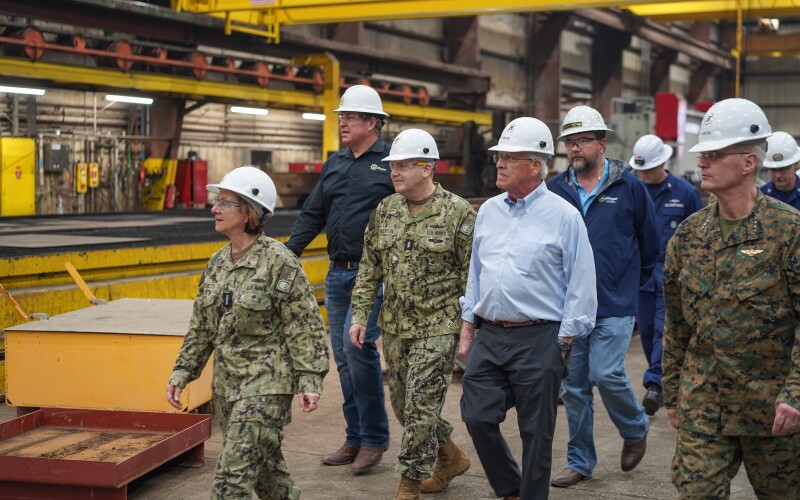Saildrone launched its first aluminum Surveyor class unmanned surface vehicle (USV) off the Austal USA production line on Mobile Bay, Ala. on March 4. Chief of Naval Operations Adm. Lisa Franchetti was on site that day to inspect the vehicle, ahead of the new USVs being tested under contract to the US Navy.
“It is tremendous to see the first vehicle launched of many that will be produced here in Alabama,” said Saildrone founder and CEO Richard Jenkins during the March 4 shipyard visit. “We are honored to have Admiral Franchetti here in person to witness the start of the creation of a new fleet of USVs alongside traditional manned ships. Everyone at Saildrone is very proud to be supporting the U.S. Navy and contributing to our defense and national security.”
Primarily designed for ocean mapping and maritime domain awareness, the 65’ Saildrone Surveyor USV is powered by wind with its 44’ tall sail wing, solar panels, and a 78-hp high-efficiency auxiliary diesel generator for long range, high endurance missions in the open ocean.
Saildrone officials say the vehicle’s speed and endurance is 6 knots over 2,500 nautical miles under power and more than 3 months under sail, with payload electrical power of 2,000 watts steady state and 4,000 watts peak. The Surveyor carries the latest multibeam sonar equipment for seafloor mapping to depths of 11,000 meters (36,000 feet) and purpose-built defense and security payloads for accurate, dynamic, and confident decisions and responses to the full spectrum of maritime threats and challenges.
Upcoming Navy missions will focus on the ability of the Surveyor to deliver both surface and undersea intelligence for a range of high-priority applications, including anti-submarine warfare (ASW).

To meet the increasing demand for Surveyor USVs, Saildrone, based in Alameda, Calif., partnered with Austal USA of Mobile, Ala. to leverage their advanced manufacturing production techniques and rapid assembly capabilities. Austal is currently producing one Surveyor every six weeks, with the ability to scale up production as demand requires.
At 20 meters long (65’) and weighing 15 tons, the Surveyor classifies as a medium USV, built to American Bureau of Shipping (ABS) Light Warship code. These first Surveyors are contracted to the U.S. Navy for the initial testing and evaluation of Surveyor-class vehicles in multiple environments.
Franchetti said unmanned systems have enormous potential to multiply the Navy and Marine Corps’ combat power by complementing forward-postured forces and the existing fleet of ships, connectors, submarines, and aircraft, especially in areas like maritime surveillance and reconnaissance, mine countermeasures operations, seabed exploration and carrier airwing support.
“Using unmanned assets helps put more players on the field by freeing up manned assets for more specific and important tasks,” said Franchetti. “It’s good to see high tech industry partnering with the traditional shipbuilding industrial base to rapidly deliver cutting-edge products at scale.”
The Navy and Marine commanders’ visit was part of a tour around Gulf of Mexico shipyards including Austal USA, Ingalls Shipbuilding and Bollinger Mississippi Shipbuilding according to a statement from Navy public affairs officials.
“This visit gave Franchetti and Mahoney the opportunity to see first-hand the shipyards’ capability and capacity and to hear from senior leadership and skilled craftsmen from three major contractors supporting amphibious shipbuilding as well as other Navy surface combatants.” Franchetti reiterated that the Navy’s goal of a ready and capable fleet includes 31 amphibious ships.

“I’m grateful for the partnership we have with Congress, with industry, and with our Navy team here that fields America’s Warfighting Navy,” said Franchetti. “The Gulf Coast shipbuilding industry is a vital part of our defense industrial base, building both manned and unmanned platforms. The investments we make in our industry partnerships is essential to putting more ready players on the field.”
While at Austal USA, the commanders also toured the shipyard and the newly delivered Independence-class Littoral Combat Ship Kingsville.
But Franchetti talked about how “Austal USA is playing a key role in putting LCS in the hands of fleet commanders who praise their versatility,” according to the Navy statement.
“The littoral combat ship is important to our Navy - these platforms have the capability to do multiple missions and we have a validated need for them,” said Franchetti. “Around the world today LCS is playing a valuable role in the surface warfare mission, and is expanding to support the mine countermeasures mission and unmanned surface vessel operations.”
At Ingalls Shipbuilding in Pascagoula, Miss., Franchetti and Mahoney also toured the San Antonio-class amphibious transport dock Richard M. McCool Jr. and the America-class amphibious assault ship Bougainville. The tour group saw progress on the Flight III Arleigh Burke-class guided missile destroyer Ted Stevens and the guided missile destroyer Zumwalt.
The Zumwalt arrived in Pascagoula last year for a two-year modernization period. Among the upgrades being added, the first-in-class destroyer is being outfitted with hypersonic missile tubes to take warfighting into the next generation. Hypersonic weapons, capable of flying at speeds greater than five times the speed of sound (Mach 5), are highly maneuverable and operate at varying altitudes.
“This is the future right here,” said Franchetti. “DDG 1000, with technology upgrades including the integration of the Conventional Prompt Strike weapon system, is quite an engineering feat and ensures Zumwalt remains one of the most technologically advanced and lethal ships in the U.S. Navy.”
This was Franchetti and Mahoney’s first combined visit to observe the Navy’s shipbuilding industry.




